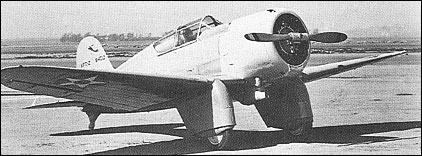|
| Despite some scepticism concerning the practicability
of the monoplane configuration for the shipboard
fighter, the US Navy's BuAer issued a second requirement for such a warplane on 24 January 1933, the first
having been issued seven weeks earlier and for which
the Boeing Model 273 was designed and built (as the
XF7B-1). To meet the later but essentially similar requirement,
a contract was let to Northrop for a prototype
assigned the designation XFT-1. A single-seat all-metal
cantilever monoplane with split flaps, spatted
main undercarriage members and an enclosed cockpit,
the XFT-1 was designed by a team led by Ed Heinemann.
Powered by a Wright R-1510-26 14-cylinder
radial rated at 600hp at sea level and 625hp at 1830m, and carrying two 7.62mm cowl
guns, the XFT-1 first flew on 16 January 1934. The US
Navy was critical of its manoeuvrability, its tendency to
spin out of certain manoeuvres, its low speed characteristics
and its landing speed. During the course of
initial tests, an XR-1510-8 engine affording 650hp at
2590m was substituted for the -26, and, in
April 1936, the XFT-1 was returned to the manufacturer
for more extensive modification. A Pratt & Whitney
R-1535-72 Twin Wasp Jnr 14-cylinder radial rated at
700hp for take-off and 650hp at 2285m was
installed, this having a long-chord cowling; the vertical
tail surfaces were enlarged, and the mainwheel spats
were revised. Redesignated XFT-2, the fighter was
now 118kg heavier in empty condition, speed
and climb performance were marginally improved, but
manoeuvrability and low speed characteristics were
worse. It was pronounced unairworthy by the US Navy
and crashed on 21 July 1936 while being returned to its
manufacturer.
 | A three-view drawing (1280 x 816) |
| MODEL | XFT-1 |
| WEIGHTS |
| Take-off weight | 1704 kg | 3757 lb |
| Empty weight | 1120 kg | 2469 lb |
| DIMENSIONS |
| Wingspan | 9.75 m | 32 ft 0 in |
| Length | 6.43 m | 21 ft 1 in |
| Height | 2.87 m | 9 ft 5 in |
| Wing area | 16.44 m2 | 176.96 sq ft |
| PERFORMANCE |
| Max. speed | 378 km/h | 235 mph |
| Range | 1570 km | 976 miles |
| Thomas Everhart, e-mail, 04.06.2016 18:15 What do want for your Wind Tunnel Model? Where is it located? Tom Everhart deadstick51@gmail.com reply | | Xavier Canale, e-mail, 21.06.2012 00:30 Hello all, I have the original wind tunnel model for the XFT-1.
It's about 6 ft long by 7 wide.
I am interest in selling it. Thank you reply | | ED, e-mail, 13.12.2010 03:32 Data is close. The prototype was tested and refused. The engine /spats /rudder were redesigned. It remained the XFT-1 and returned to NAS Anacostia for Navy flight test. The Navy informed Northrop the plane had such poor spin recovery that they felt the plane should be taken back to Calif. on a train flat car. The Northrop pilot felt he could fly it back and over the Appalachian mountains in a storm the pilot was forced to jump and the plane crashed. Northrop had the XFT-2 which was the same design as the modified XFT-1 and was lost over the pacific ocean during a test flight. My dad (E.R. Moore) took 4 pics of the modified XFT-1 when it landed at Biggs Field (El Paso) on it's return trip to NAS Anacostia. I have the negs to a couple of them and when I found Northrop didn't have any pics of the modified XFT-1 I sent them some. ....emo reply | | AWESOME!, e-mail, 01.03.2008 15:24 Do you thinki could write a five-page report on this aircraft? reply |
|
Do you have any comments?
|
| 
COMPANY
PROFILE
All the World's Rotorcraft
|








